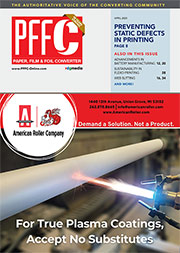Featured Stories
-
Advantages of Shear, Razor and Crush Web Slitting Techniques
When choosing a slitting method, many factors must be considered, including interaction with inspection systems. -
Revolutionizing Lithium-lon Battery Manufacturing Advances in Slot-Die and Electrode Coating Technology
As the global battery market surges toward an estimated $328 billion by 2028, innovations in manufacturing processes are becoming increasingly... -
Nordson Divisions Collaborate to Achieve Unprecedented Flat Profile Time
Nordson Measurement & Control Solutions (a division of Nordson Corporation) is a global leading provider of gauging systems for the film...
News | New Products
-
Morris Packaging to Add New KY Flex-pack Plant
Bloomington, IL-based Morris Packaging plans to build a new $60.9-million production plant in Marion County (KY), a project that will create 276 full-time jobs.
-
Press Belt Manufacturer IPCO to Focus on Engineering and Service Expertise
IPCO will use Ligna 2025 to highlight the service and support services it provides to press manufacturers and WBP producers alike.
-
INX promotes seven Executives to Vice President positions
INX International Ink Co. has announced the Board of Directors has approved the promotions of seven key people to Vice President positions.
-
Bimec and Flex CA Strengthen U.S. Market Presence with a new installation at Cello-Wrap Packaging Inc.
Bimec and Flex CA proudly announce a new milestone in their U.S. market expansion with the recent commissioning of a state-of-the-art slitter rewinder at Cello-Wrap Packaging Inc, located in Farmersville - TX.
-
New Era Converting promotes industry veteran Stephen Pickett to controls engineering manager
New Era Converting, an IPCO company, has announced that Stephen Pickett is taking on a new role as controls engineering manager.
-
Fedrigoni Announces New Slitting Center for Self-Adhesive Labels in Germany in Q4 2025
The Fedrigoni Group - a world reference in the manufacturing of self-adhesive labels, special papers for packaging and other creative applications, graphic supports for visual communication and RFID
-
Advancing Label Innovation Through Collaboration
Packaging is a physical representation of a brand’s identity, and label converters play an essential role in bringing the packaging experience to life.
Expert Advice
What's Ahead for Industrial Ink Jet?
- Published: August 01, 2003, By Ken Stack, Jetrion LLC
What are the best uses for ink jet in an industrial setting? An expert answers questions about the basics of ink jet technology.
Ink jet printing is a well-established, cost-effective solution for short-run and variable information applications. With improvements in print speed and quality, ink jet printing quickly is being integrated into converting operations.
Q: How does ink jet printing differ from other digital printing systems, and what are the benefits it provides to converters?
A: Ink jet is a computer-to-print technology in which digital signals drive droplets of ink through a printhead and then directly onto a substrate. Ink jet printing differs from other plateless digital technologies, like copier or toner-based technologies, because it is noncontact. Ink jet has the ability to print on a wide variety of materials and products, including non-flat surfaces, because the printing device never comes into contact with the substrate.
Like many digital printing systems, ink jet is known for the benefits that it provides for short-run print and variable information applications. But its potential is far greater. Industrial ink jet printing systems can be integrated into existing traditional printing systems cost-effectively to enable converters to provide single-source solutions for customers.
Q: What advice would you give converters looking to integrate ink jet technology into existing traditional printing systems?
A: When considering an investment in ink jet technology, converters should focus first on customer needs — like application, time-to-market, print run, print quality, and cost parameters — rather than the technology itself.
To maximize ROI, they also should consider how ink jet technology will fit into their existing print operations. They must decide whether to incorporate in-line or off-line, and they must understand how the components of their printing systems interact. A good digital printing technology supplier will help them on both fronts.
Q: How do operators decide between drop-on-demand (DOD) or continuous ink jet (CIJ) technology for their printing systems?
A: Speed and print quality are the key considerations. CIJ and DOD are both computer-to-substrate processes — processes that don't require a press — but the action of propelling the ink to substrate is quite different in each.
Most industrial ink jet systems use CIJ technologies. With CIJ, drops of ink are generated in a stream and deflected through a plate to produce an image. Industrial CIJ systems have speeds to 1,000 fpm. That's much faster than DOD. But the image quality is lower than that with DOD technology.
CIJ is the solution of choice for large direct mail-order operations and for product coding and marking in package printing applications for the food, beverage, pharmaceutical, and beauty aide markets. It's also being used in marking and coding lottery tickets.
With DOD, a digital signal produces a single drop of ink on the substrate rather than a stream of ink. Color is formed in a precise collection of dots — not too dissimilar from traditional offset printing. DOD is the ideal choice for full-color, high-precision printing, where quality is the most important consideration. DOD printing can produce near-photographic quality results. DOD can handle print speeds between 100 and 300 fpm.
Applications for DOD include wide-format printing, colored graphics for packaging, point-of-purchase displays, textile, and large format/signage. Many companies are working on devices that will allow DOD to be used for packaging applications as well, such as blister packaging for pharmaceuticals, private label for high-end packaging, and peel lids for special product promotions. However, today they remain niche products due to printing speed constraints.
Q: What types of inks are available today for industrial ink jet printing systems?
A: Just about all — water-, oil- and solvent-based inks and energy-curable inks.
However, converters should make careful choices when selecting ink systems. They have to balance how efficiently the ink runs through a print system with how well the ink performs once it's printed. Working with an ink jet supplier that understands how digital hardware, software, and ink interact is critical to preventing problems and making optimal use of ink jet printing systems.
Q: What substrates/printed media currently are best suited to ink jet technology?
A: Advancements in ink jet inks provide the flexibility to print on just about any medium. Ink jet technology is used in color-proofing for wide-format printing of textiles like wallpaper, carpeting, and even tiles. We're seeing growth in ink jet printing on glass and plastics for packaging applications. Of course, it continues to be used to print on paper and synthetic substrates.
Many substrates today are coated prior to being printed with ink jet, but advances in ink technology are beginning to remove this requirement. The wide range of inks available today continues to expand the range of substrates that can be used for industrial ink jet printing applications.
Q: Are converters concerned about past disappointments with digital systems and suppliers?
A: Indeed, a lot of converters made an investment in digital technology but were disappointed because the digital industry promised more than it could deliver. Misinformation, poor service, and a lack of understanding of the actual customer's requirements have limited the growth of ink jet for packaging. Success is much more than buying an ink jet printer.
Training and management are two considerations that have been overlooked. Managing new workflow, variable data, and image processing are critical to making sure a digital system runs smoothly.
Q: What's the future potential for ink jet technology?
A: Limitless. Packaging is going to be the application to drive ink jet printing into true industrial applications. So in the short run, say the next five to ten years, package printers will see a continuous development of hybrid technologies. Ink jet devices and traditional printing equipment will work in tandem. The digital device will be used to print only variable data — the graphics or text required to change during the run. This will allow end-users to maximize their previous investments while taking advantage of the latest technologies.
Decreasing costs, increasing speeds, and the aging of traditional printing equipment also will drive the adoption of ink jet technology. Over time, converters slowly will begin replacing their existing printing equipment with digital systems. That, however, is many, many years away.
Ken Stack is president of Jetrion LLC, a digital printing company offering a fusion of digital ink, hardware, software, and service solutions to industrial and commercial printers. Jetrion was launched in February 2003 by Flint Ink; Stack is the former VP/general manager of Flint Ink's Digital Div.
The views and opinions expressed in Technical Reports are those of the author(s), not those of the editors of PFFC. Please address comments to author(s).













